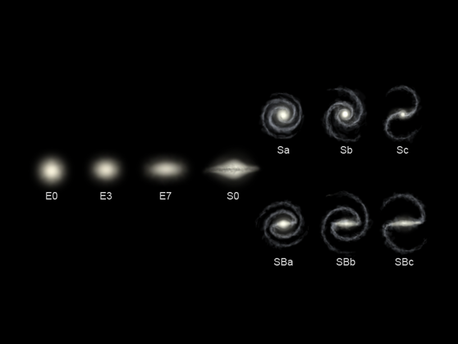Astronomers Explain Hubble Sequence
How Galaxies Came To Be
 © Ville Koistinen
|
A figure illustrating the Hubble sequence. On the left are elliptical galaxies, with their shapes ranging from spherical (E0) to elongated (E7). Type S0 is intermediate between elliptical and spiral galaxies. The upper right line of objects stretch from Sa (tightly wound spiral) to Sc (loosely wound spiral). The lower right line shows the barred spirals that range from the tightly wound SBa to loosely wound SBc types.
Explaining the Hubble Sequence is complex. The different types clearly result from different evolutionary paths but until now a detailed explanation has eluded scientists.
Benson and Devereux combined data from the infrared Two Micron All Sky Survey (2MASS) with their sophisticated GALFORM computer model to reproduce the evolutionary history of the Universe over thirteen billion years. To their surprise, their computations reproduced not only the different galaxy shapes but also their relative numbers.
“We were completely astonished that our model predicted both the abundance and diversity of galaxy types so precisely”, said Devereux. “It really boosts my confidence in the model”, added Benson.
The astronomers’ model is underpinned by and endorses the ‘Lambda Cold Dark Matter’ model of the Universe. Here ‘Lambda’ is the mysterious ‘dark energy’ component believed to make up about 72% of the cosmos, with cold dark matter making up another 23%. Just 4% of the Universe consists of the familiar visible or ‘baryonic’ matter that makes up the stars and planets of which galaxies are comprised.
Galaxies are thought to be embedded in very large haloes of dark matter and Benson and Devereux believe these to be crucial to their evolution. Their model suggests that the number of mergers between these haloes and their galaxies drives the final outcome – elliptical galaxies result from multiple mergers whereas disk galaxies have seen none at all. Our Milky Way galaxy’s barred spiral shape suggests it has seen a complex evolutionary history, with only a few minor collisions and at least one episode where the inner disk collapsed to form the large central bar.
“These new findings set a clear direction for future research. Our goal now is to compare the model predictions with observations of more distant galaxies seen in images obtained with the Hubble and those of the soon to be launched James Webb Space Telescope (JWST)”, said Devereux.
Source: Royal Astronomical Society
Astronomers Explain Hubble Sequence
How Galaxies Came To Be
 © Ville Koistinen
|
A figure illustrating the Hubble sequence. On the left are elliptical galaxies, with their shapes ranging from spherical (E0) to elongated (E7). Type S0 is intermediate between elliptical and spiral galaxies. The upper right line of objects stretch from Sa (tightly wound spiral) to Sc (loosely wound spiral). The lower right line shows the barred spirals that range from the tightly wound SBa to loosely wound SBc types.
Explaining the Hubble Sequence is complex. The different types clearly result from different evolutionary paths but until now a detailed explanation has eluded scientists.
Benson and Devereux combined data from the infrared Two Micron All Sky Survey (2MASS) with their sophisticated GALFORM computer model to reproduce the evolutionary history of the Universe over thirteen billion years. To their surprise, their computations reproduced not only the different galaxy shapes but also their relative numbers.
“We were completely astonished that our model predicted both the abundance and diversity of galaxy types so precisely”, said Devereux. “It really boosts my confidence in the model”, added Benson.
The astronomers’ model is underpinned by and endorses the ‘Lambda Cold Dark Matter’ model of the Universe. Here ‘Lambda’ is the mysterious ‘dark energy’ component believed to make up about 72% of the cosmos, with cold dark matter making up another 23%. Just 4% of the Universe consists of the familiar visible or ‘baryonic’ matter that makes up the stars and planets of which galaxies are comprised.
Galaxies are thought to be embedded in very large haloes of dark matter and Benson and Devereux believe these to be crucial to their evolution. Their model suggests that the number of mergers between these haloes and their galaxies drives the final outcome – elliptical galaxies result from multiple mergers whereas disk galaxies have seen none at all. Our Milky Way galaxy’s barred spiral shape suggests it has seen a complex evolutionary history, with only a few minor collisions and at least one episode where the inner disk collapsed to form the large central bar.
“These new findings set a clear direction for future research. Our goal now is to compare the model predictions with observations of more distant galaxies seen in images obtained with the Hubble and those of the soon to be launched James Webb Space Telescope (JWST)”, said Devereux.
Source: Royal Astronomical Society






